Key takeaways:
- Effective communication and planning are essential for successful event logistics in art galleries.
- Flexibility in logistics allows for unexpected opportunities and enhances the guest experience.
- Creating a structured timeline with key milestones reduces stress and improves coordination among stakeholders.
- Building strong vendor relationships and anticipating potential challenges can lead to smoother event execution.
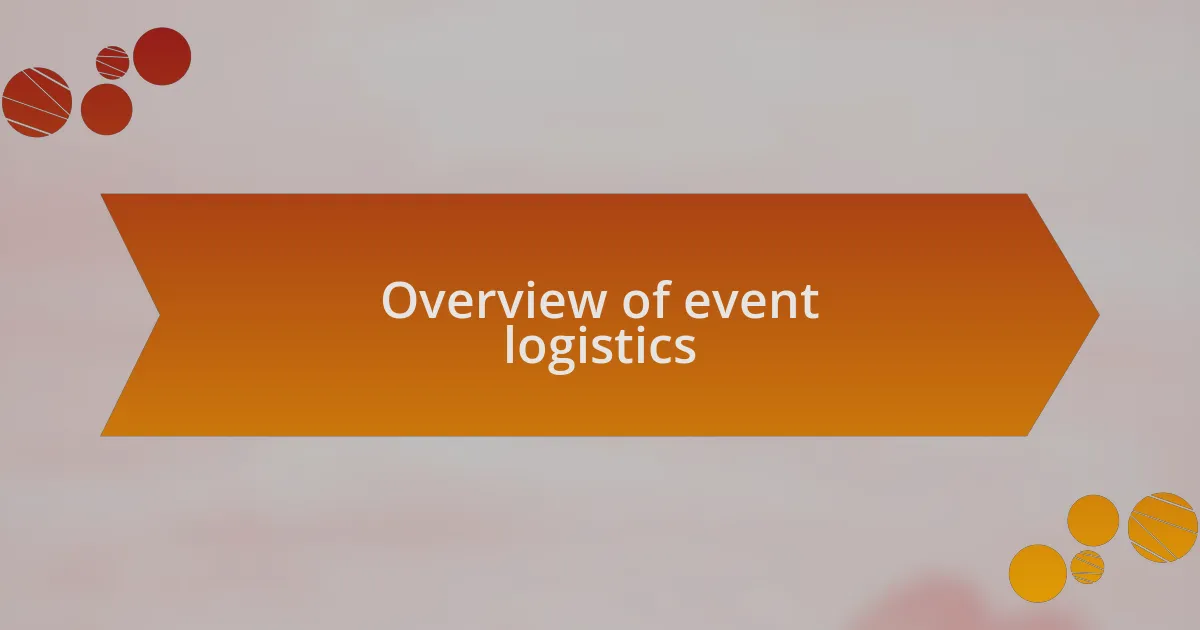
Overview of event logistics
Event logistics is the backbone of any successful exhibition or gathering, particularly in an art gallery setting. From coordinating the transportation of artworks to ensuring all technical aspects are seamlessly in place, every detail matters. I still remember the first major exhibit I organized; the thrill was palpable, but it quickly turned into a whirlwind of checklist items to manage.
What often surprises many is the sheer complexity of managing people alongside the logistics. Have you ever considered how many hands are involved in putting up an exhibition? The teamwork required to unite artists, curators, staff, and volunteers creates a unique dynamic that can either propel the event to greatness or lead to chaos. I learned this firsthand when a critical delivery was late, pushing everyone to communicate effectively and come together to find a last-minute solution.
In my experience, successful events hinge on anticipating challenges before they arise. I frequently ask myself, “What can go wrong, and how can I prevent it?” This proactive thinking not only eases the pressure during the event but also fosters an environment of creativity and collaboration. Picture this: a last-minute change in the layout leads to an impromptu idea for an engagement station that becomes a highlight of the gallery. Embracing flexibility within the logistics framework allows for unexpected opportunities to shine.
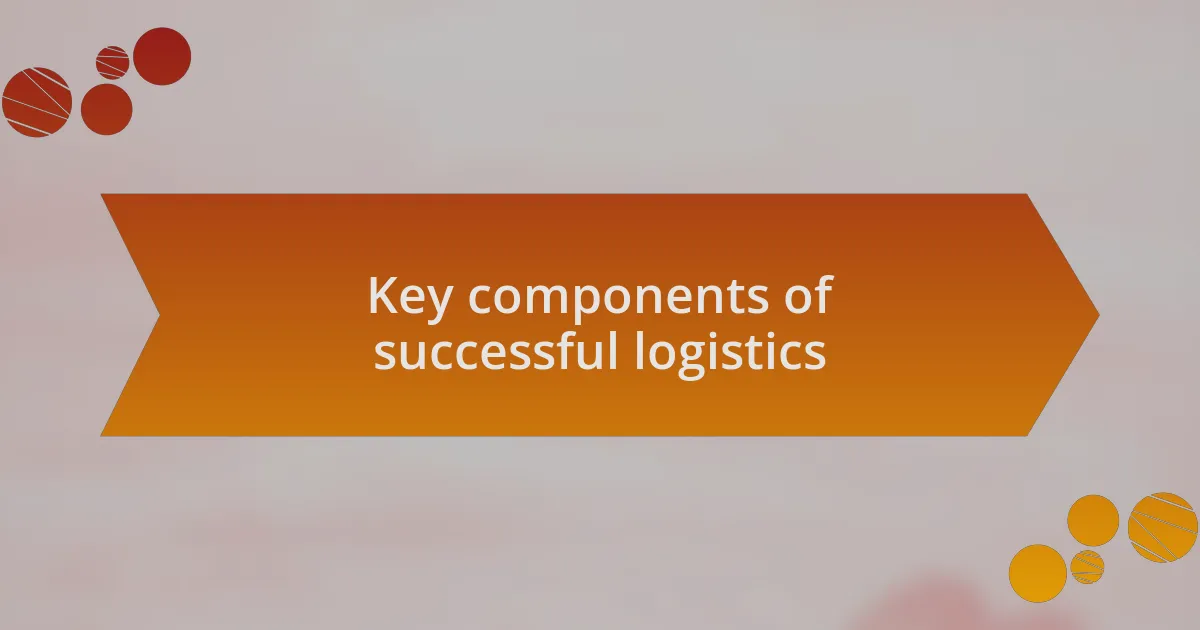
Key components of successful logistics
The key components of successful logistics in an art gallery event are effective communication and planning. I often create a timeline to help everyone involved understand their roles and deadlines. Have you ever tried to coordinate multiple vendors and artists? Maintaining clear lines of communication can turn potential chaos into synchronized harmony.
Another critical element is resource allocation—ensuring that you have the right materials and personnel at the right time. Once, I faced a situation where we ran short on display stands just before an opening. By remembering to account for every detail in my initial resources planning, I managed to source alternatives quickly. It’s about being prepared and thinking two steps ahead.
Finally, I believe in the importance of flexibility in logistics. Events can shift in unexpected ways, and the ability to pivot is invaluable. During one exhibit, we had to relocate a piece that didn’t fit the planned layout. Instead of seeing it as a setback, I viewed it as an opportunity to create a more engaging viewing path. The outcome? Attendees discovered new perspectives, all because we embraced a change in logistics.
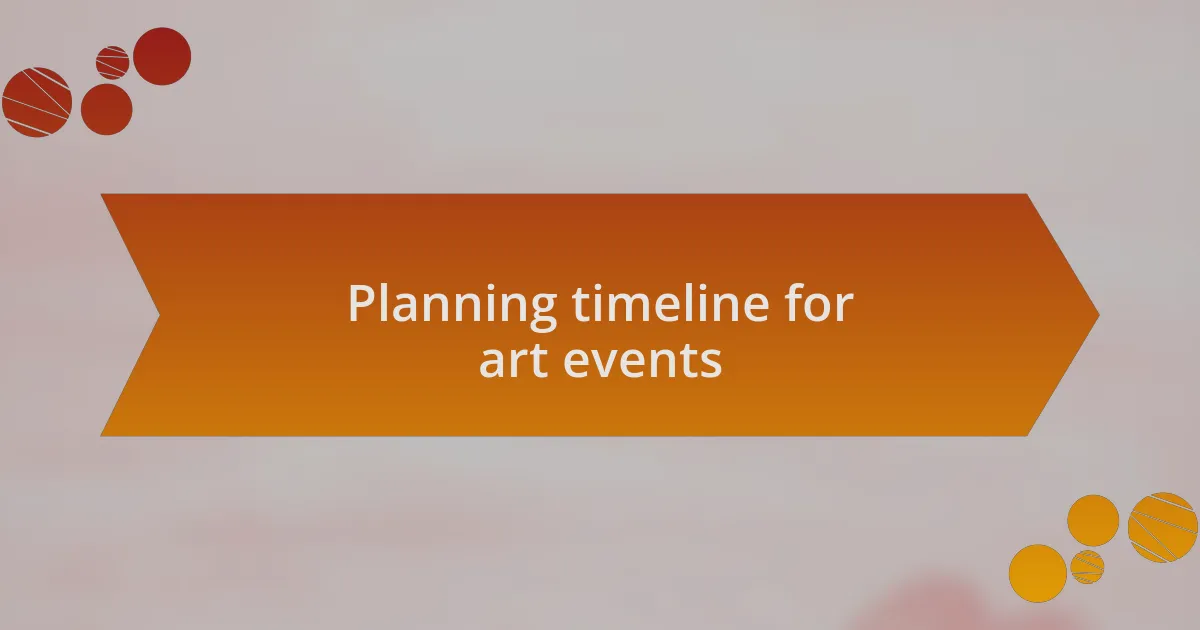
Planning timeline for art events
When planning the timeline for art events, I often start by mapping out key milestones. For instance, setting a date for the exhibition launch well ahead of time allows for adequate preparation for artists and installers. Have you ever felt the pressure of last-minute changes? By prioritizing these timelines, I’ve successfully reduced stress for everyone involved.
I break down the planning into phases, from initial concept to final execution. Each phase includes specific tasks, deadlines, and check-ins. One time, I assigned vendors a timeline two months prior to an event. This not only kept them accountable but also gave us room to troubleshoot any issues. Having that structure made the entire process flow so much smoother.
Moreover, I’ve found that building in buffers for unexpected developments is essential. For example, if there’s a need for extra time during the setup, it’s crucial to have it included in the timeline. Reflecting on previous events, my flexibility with time has often led to improved opportunities to enhance the guest experience. Have you considered how a well-structured timeline could elevate your art event? Planning isn’t just about dates; it’s about creating a seamless journey for everyone involved.
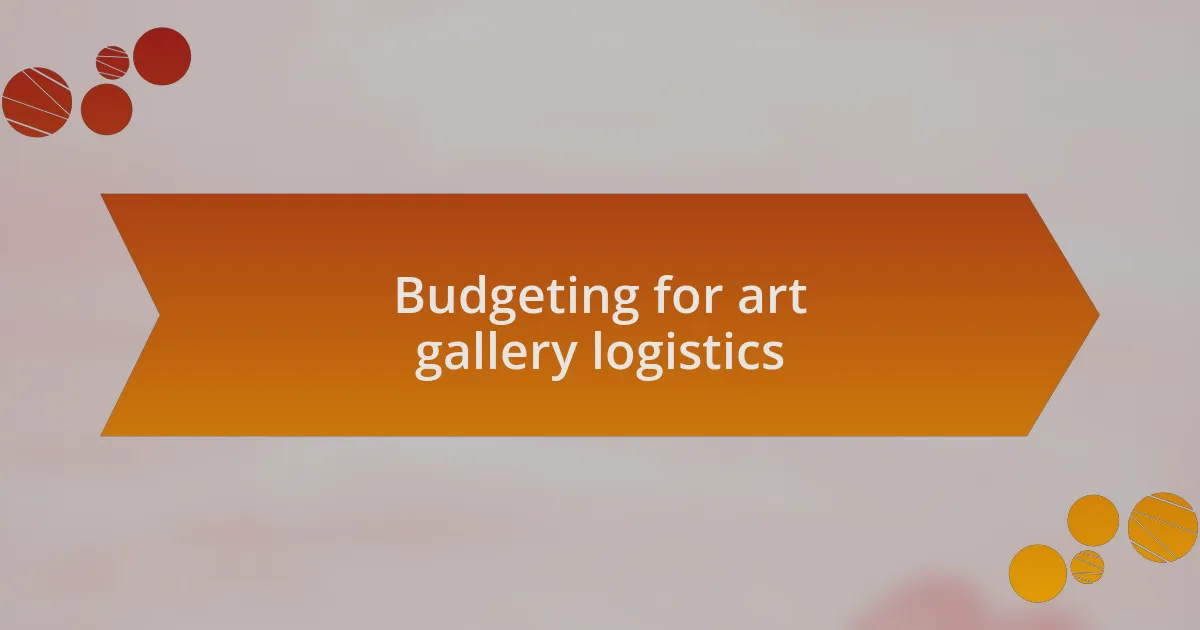
Budgeting for art gallery logistics
Budgeting for art gallery logistics requires a blend of precision and flexibility. In my experience, I’ve found that breaking down costs into categories—like venue rental, transportation, and promotional materials—helps create a clearer financial picture. Have you ever underestimated the shipping costs for artwork? Once, I had to adjust our budget mid-event because freight charges were much higher than I anticipated, reminding me how crucial it is to plan for every detail.
When drafting a budget, I prioritize transparency with all stakeholders. Sharing financial outlines with artists and vendors not only fosters trust but also enables better collaboration. I recall a scenario where an artist was hesitant about our proposed budget until I provided a detailed explanation of how funds were allocated. This openness turned skepticism into partnership, ultimately enriching the event’s outcome.
Another key aspect involves setting aside contingency funds for those unexpected surprises. During one exhibition, a last-minute installation change meant additional costs for materials. By having a small reserve, I could address this without derailing the entire budget. I always ask myself, “What if something goes awry?” That mindset has saved me on numerous occasions, ensuring I can maintain the integrity and quality of the event without financial strain.
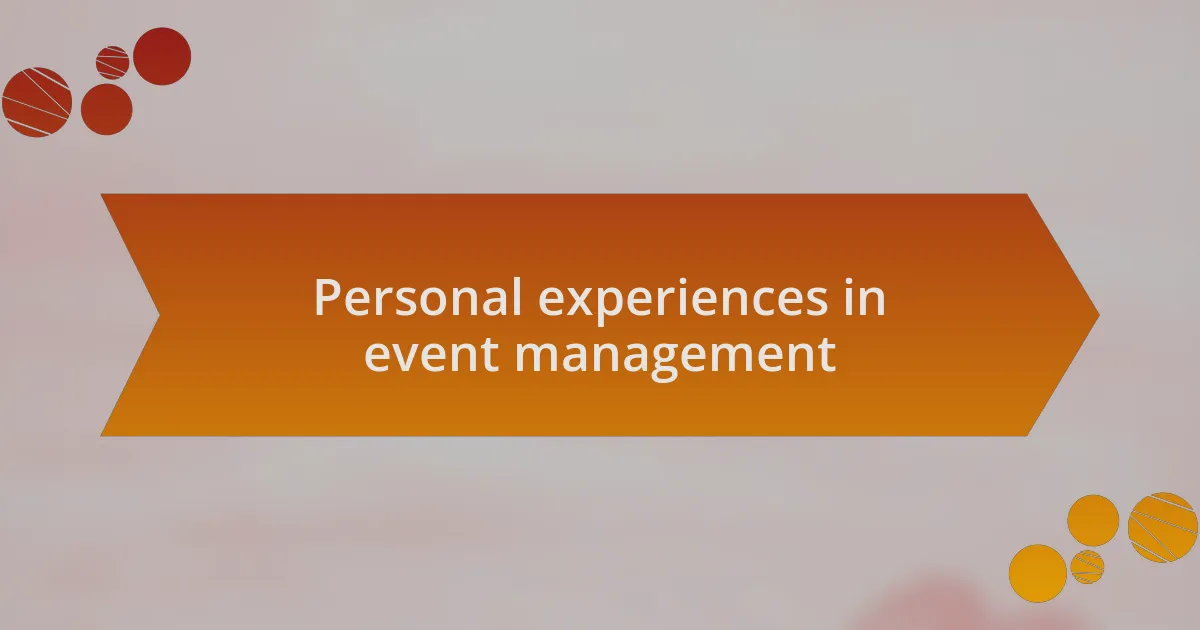
Personal experiences in event management
When it comes to personal experiences in event management, one memory stands out. I was once tasked with organizing a gallery opening that had several moving parts. The day before the event, I found out the main speaker wouldn’t be able to attend. Panic set in momentarily, but I quickly reached out to a local artist who graciously agreed to step in. In that moment, I learned how adaptability is as crucial as planning. What was supposed to be a meltdown turned into a celebration of community support.
In another instance, I discovered the importance of clear communication. I remember coordinating with a catering team that misinterpreted our menu. The night before the event felt overwhelmingly stressful as I scrambled to rectify the mix-up. It taught me that when everyone understands their role and the plans are conveyed clearly, the entire experience flows more smoothly. Have you experienced similar miscommunications? It’s one of those reminders that clarity can save a lot of hassle.
Finally, I’ll never forget the feeling of watching the event come together seamlessly after days of hard work. During one art exhibition, the energy was electrifying as artists mingled with attendees, and I realized how impactful a well-executed event can be. Seeing the joy on both artists’ and visitors’ faces reaffirmed my passion for event management. What is more rewarding than creating a space where art thrives and connections blossom? Each event reinforces my belief that logistics are the backbone of success, making every challenge worth it in the end.
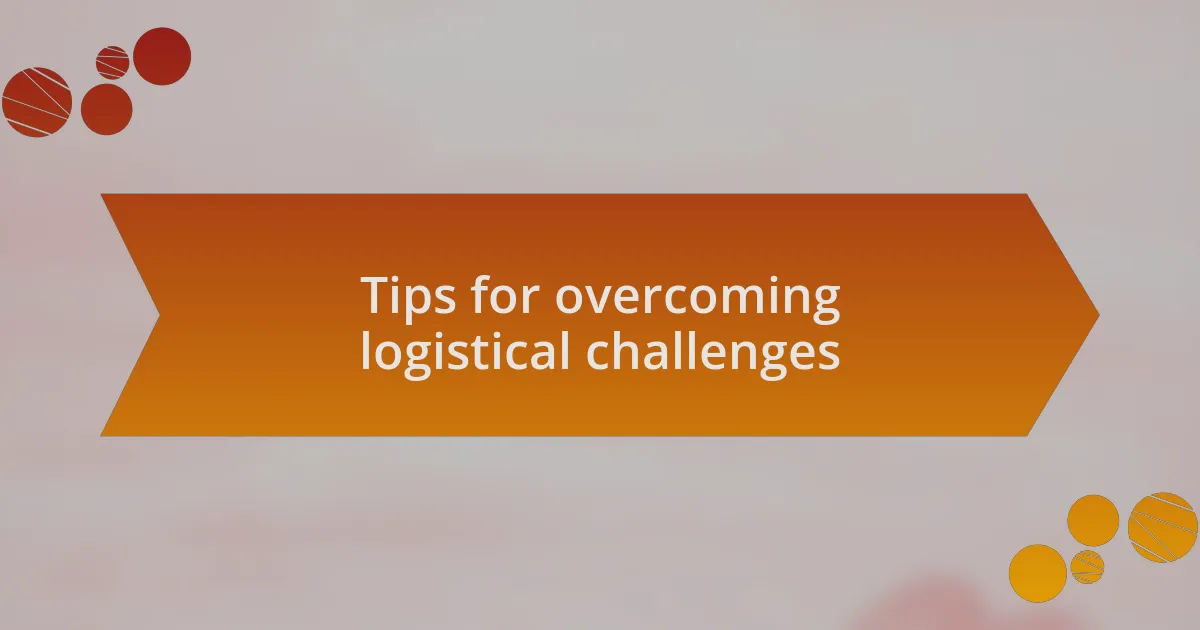
Tips for overcoming logistical challenges
One of the biggest logistical challenges I’ve faced was managing transportation for featured artwork at an exhibition. I vividly remember the stress that came with ensuring fragile pieces were handled with care. To tackle this, I developed a checklist outlining the specific requirements for each artwork, which included the type of vehicle needed and the packing materials. This preparation not only minimized risks but also streamlined the process, allowing everyone involved to feel confident.
Another important tip is to build relationships with local vendors in advance. During a previous event, I encountered a last-minute need for additional lighting. Thankfully, I knew a lighting company that could provide exactly what we required. This experience taught me that having a network of reliable contacts can make a world of difference when unexpected needs arise. Have you ever faced a similar situation? I know I’ve learned to appreciate those connections greatly.
Finally, I find that anticipating potential problems is essential. For instance, during an indoor event, I noticed the flow of foot traffic could create congestion near the entrance. By repositioning furniture and signage just hours before the doors opened, I was able to facilitate better movement and set a welcoming tone. It truly showed me that being proactive rather than reactive can transform challenges into smooth experiences. How do you approach unexpected issues in event planning? I always advise thinking a few steps ahead to keep everyone engaged and happy.